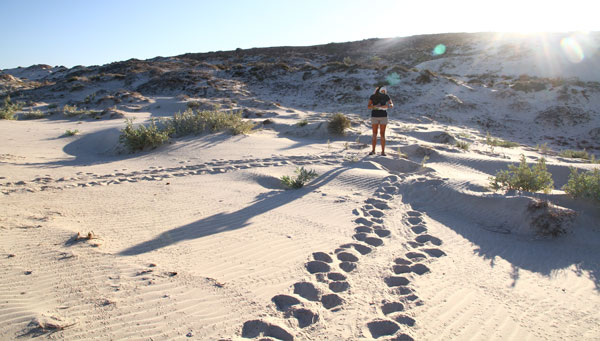
Monitoring and protecting nesting beaches is critical for the successful conservation of sea turtles. Although some rookeries around the world are well studied, many other nesting aggregations, especially those in remote or undeveloped regions, remain poorly monitored.
Surveys carried out by the Gnaraloo Turtle Conservation Program since 2008 have revealed that the southern end of the Ningaloo Coast contains important and previously under-estimated nesting aggregations of loggerhead species.
Assessments by the International Union for Conservation of Nature (IUCN) note that the South Eastern Indian Ocean loggerhead sub-population is near threatened (Casale et al. 2015). As such, the population is largely dependent on conservation efforts, so Gnaraloo Turtle Conservation Program’s efforts to protect the loggerhead turtle nesting areas on its coastline helps to ensure the survival of loggerhead nests, eggs and hatchlings.


The Gnaraloo Turtle Conservation Program and the Gnaraloo Feral Animal Control Program target matters of National Environmental Significance under the Environment Protection and Biodiversity Conservation Act 1999 (Australia), namely:
• nationally significant species in the form of threatened fauna (endangered and vulnerable reptiles)
• key threatening processes (feral predation of turtle eggs and hatchlings).
The Gnaraloo rookeries are important mainland nesting areas for loggerheads in Western Australia.
LOGGERHEAD TURTLE
(Caretta caretta)
Conservation status: endangered
Age at maturity: around 30 years
Average length: 80-120cm
Average weight: 70-146kg
Diet: omnivore
Clutch size: around 112 eggs
Clutches laid per season: average 3-4 at about 2-week intervals
Remigration interval: females return to nest every 2-5 years


The Gnaraloo Turtle Conservation Program currently focuses on two high density turtle rookeries: the Gnaraloo Bay Rookery and the Gnaraloo Cape Farquhar Rookery where loggerhead turtles (Caretta caretta) are the primary nesting species.
The Gnaraloo Turtle Conservation Program collects baseline data on sea turtle nesting activities along the Gnaraloo coastline. Its goal is to identify trends and required management to protect endangered marine species and critical coastal nesting habitat. The program also trains scientific and other professionals and engages the community and schools in conservation activities.
How many loggerhead nesting activities occur at the Gnaraloo Bay Rookery?
SEASON
2008/09
2009/10
2010/11
2011/12
2012/13
2013/14
2014/15
2015/16
2016/17
2017/18
NESTING ACTIVITIES
–
731
758
700
672
635
528
479
695
512
NESTS
319
480
399
324
303
424
328
304
405
284
EST. NUMBER OF FEMALES
62 – 76
97 – 119
78 – 96
65 – 79
58 – 71
80 – 98
61 – 75
56 – 69
77 – 94
53 – 65


During nesting seasons 2015/16 and 2017/18, we satellite tracked 12 Western Australian post-nesting loggerheads, at Gnaraloo Bay and Gnaraloo Cape Farquhar, to help understand inter-nesting movements, post-nesting migrations, and identify foraging grounds and potential threats across the turtles’ entire nesting range in Western Australia.
Continue reading
Feral animal control
The Gnaraloo Feral Animal Control Program protects the coastal nesting rookeries of endangered sea turtles at Gnaraloo through minimizing feral animal predation of turtle eggs and hatchlings.
Sea turtle migrations
During sea turtle nesting seasons 2015/17, the Gnaraloo Turtle Conservation Program undertook the first ever satellite tracking of loggerhead females that nest on the Gnaraloo coastline.

